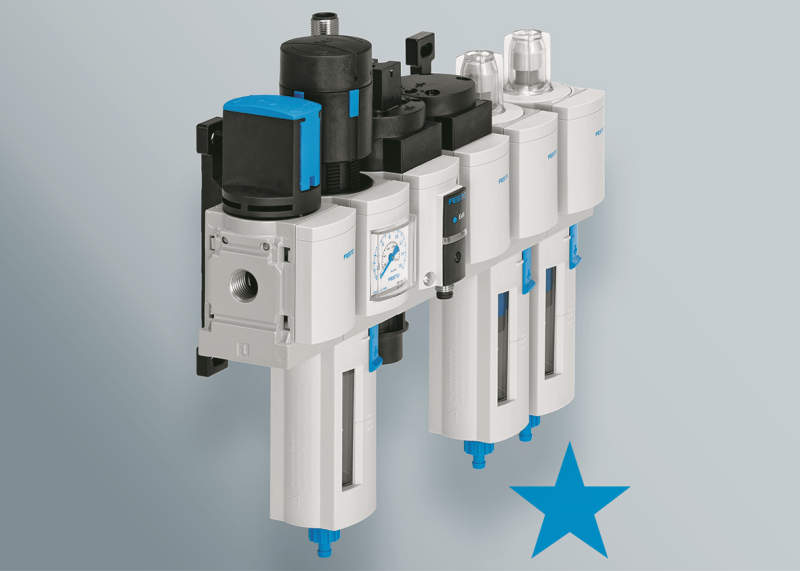 Festo, the leading supplier of automation technology, has developed a series of technical resources designed to help engineers optimise air preparation to improve process reliability, machine availability and service life in pneumatic systems. Available at www.festo.co.uk/stars-airprep, engineers can view a series of short tutorial videos, review the top tips summary or download a white paper entitled: “Compressed air preparation in pneumatics”. In addition, highlighted with a ‘blue star’ in its catalogue, Festo’s core range for pneumatics combines proven high quality with next day delivery and attractive pricing.
Festo, the leading supplier of automation technology, has developed a series of technical resources designed to help engineers optimise air preparation to improve process reliability, machine availability and service life in pneumatic systems. Available at www.festo.co.uk/stars-airprep, engineers can view a series of short tutorial videos, review the top tips summary or download a white paper entitled: “Compressed air preparation in pneumatics”. In addition, highlighted with a ‘blue star’ in its catalogue, Festo’s core range for pneumatics combines proven high quality with next day delivery and attractive pricing.
“A correctly specified and sized air preparation set is essential to the smooth running of your pneumatic system,” explains Aruj Abbas, product marketing manager for air supply at Festo. “Particles, water and oils in compressed air can lead to mechanical friction, corrosion or clogging. Following simple preventative steps can significantly improve service life, energy efficiency and system availability, ensuring your machine functions to its full capacity.”
Whether designing, specifying, building or maintaining pneumatic systems, these technical resources offer practical advice on how to optimise your system to ensure maximum machine performance, uptime and service life. Top tips include:
1. Check the flow rates of fine filters: Flow rates might meet overall application requirements, but this can be misleading. Grid sizes on fine and micro filter units slow down air flow considerably – often leading to running the system at higher pressure to compensate, increasing energy usage. The solution is to use standard connecting plates, allowing fine and micro filters to be larger in size than the rest of the air prep set, enabling optimum flow rates throughout the system.
2. Avoid water in the system: Liquids such as water in the system lead to corrosion, generating rust particles that can cause mechanical damage or block small flow cross sections. Installing condensate drains within filter units helps prevent carry-over of extracted liquid into the downstream air flow. These range in cost and complexity from fully automatic drains that automatically vent as the condensate builds up, to fully manual drains that rely upon regular maintenance inspections.
3. Use easy-to-read pressure gauges: Gauges with pre-set operating zones enable fast setting and monitoring of operating pressure without relying upon skilled technicians. With only a quick glance, operators can easily check all is well. The optimum operating pressure can be easily displayed within a green zone. Pressure regulators are adjusted to set the needle within this range.
4. Reduce air pressure to the machine: Minimise air consumption and energy usage as far as possible. Often, machine pressure is determined by the requirements of only one or two components. By introducing pressure zones – either with a regulator on those components or by installing a pressure booster feeding a local reservoir – the overall air pressure of the machine can be reduced. Additional hardware costs are quickly recovered as a lower air pressure setting can be maintained for the whole machine, reducing air consumption and energy costs.
5. Correctly size air preparation units: Pay attention to flow rates quoted for air preparation units: oversized filter bowls will not function optimally. Relying upon inducing a swirl action on the air flow, they only function at their best when the velocity of the air flow meets the design criteria. Don’t undersize – but don’t oversize either: it wastes money and impairs performance.
6. Monitor or inspect filter elements: Monitor filter elements regularly, changing them before they lose efficiency and effectiveness. Clogged filter elements fail to remove particulates and reduce flow rate by up to 50%. Contamination gauges or flow meters should be fitted, particularly for fine and micro filter elements. Stocking and replacing filter elements is a low cost, simple maintenance task that can reap large dividends in filter performance and avoiding pressure drop.
Learn how to optimise air preparation for your pneumatic system by viewing the tutorial videos or downloading the white paper at: www.festo.co.uk/stars-airprep

